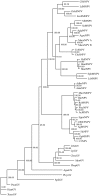Genomic sequence analysis of granulovirus isolated from the tobacco cutworm, Spodoptera litura
- PMID: 22132235
- PMCID: PMC3223241
- DOI: 10.1371/journal.pone.0028163
Genomic sequence analysis of granulovirus isolated from the tobacco cutworm, Spodoptera litura
Abstract
Background: Spodoptera litura is a noctuid moth that is considered an agricultural pest. The larvae feed on a wide range of plants and have been recorded on plants from 40 plant families (mostly dicotyledons). It is a major pest of many crops. To better understand Spodoptera litura granulovirus (SpliGV), the nucleotide sequence of the SpliGV DNA genome was determined and analyzed.
Methodology/principal findings: The genome of the SpliGV was completely sequenced. The nucleotide sequence of the SpliGV genome was 124,121 bp long with 61.2% A+T content and contained 133 putative open reading frames (ORFs) of 150 or more nucleotides. The 133 putative ORFs covered 86.3% of the genome. Among these, 31 ORFs were conserved in most completely sequenced baculovirus genomes, 38 were granulovirus (GV)-specific, and 64 were present in some nucleopolyhedroviruses (NPVs) and/or GVs. We proved that 9 of the ORFs were SpliGV specific.
Conclusions/significance: The genome of SpliGV is 124,121 bp in size. One hundred thirty-three ORFs that putatively encode proteins of 50 or more amino acid residues with minimal overlap were determined. No chitinase or cathepsin genes, which are involved in the liquefaction of the infected host, were found in the SpliGV genome, explaining why SpliGV-infected insects do not degrade in a typical manner. The DNA photolyase gene was first found in the genus Granulovirus. When phylogenic relationships were analyzed, the SpliGV was most closely related to Trichoplusia ni granulovirus (TnGV) and Xestia c-nigrum granulovirus (XecnGV), which belong to the Type I-granuloviruses (Type I-GV).
Conflict of interest statement
Figures





References
-
- Lange M, Jehle JA. The genome of the Cryptophlebia leucotreta granulovirus. Virology. 2003;317:220–236. - PubMed
-
- Martignoni ME, Iwai PJ. A catalogue of viral diseases of insects, mites and ticks. In: Burges HD, editor. Microbial Control of Pests and Plant Diseases. New York & London: Academic Press; 1981. pp. 879–911.
-
- Murphy FA, Fauquet CM, Bishop DHL, Ghabrial SA, Jarvis AW, et al. Virus Taxonomy - 6th Report of the International Committee on Taxonomy of Viruses. Arch Virol Suppl. 1995;10:1–586. - PubMed
-
- van Regenmortel MHV, Carstens EB, Estes MK, Lemon SM, Maniloff J, et al. San Diego: Academic Press; 2000. Virus Taxonomy-Seventh Report of the International Committee on Taxonomy of Viruses. 1162 p.
-
- Jehle JA, Blissard GW, Bonning BC, Cory JS, Herniou EA, et al. On the classification and nomenclature of baculoviruses: a proposal for revision. Arch Virol. 2006;151:1257–1266. - PubMed
Publication types
MeSH terms
Substances
Associated data
- Actions
LinkOut - more resources
Full Text Sources

